The grass Tuctoria mucronata, which is known by several common names including prickly spiralgrass, Solano grass, and Crampton's tuctoria, is a federally listed endangered plant species endemic to two counties in northern California.

Pogogyne abramsii is a rare species of flowering plant in the mint family known by the common name San Diego mesa mint.

Limnanthes vinculans, the Sebastopol meadowfoam, is an endangered species of meadowfoam found only in the Laguna de Santa Rosa in Sonoma County, California, United States and an area slightly to the south in the Americano Creek and Washoe Creek watersheds. The name vinculans derives from the Latin root vinculum, meaning "a bond, a cord." The specific epithet vinculans means linking or bonding, in reference to the sharing of some characters of L. vinculans with L. douglasii (R.Br) and L. bakeri.
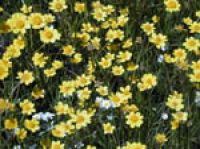
Lasthenia conjugens, commonly known as Contra Costa goldfields, is an endangered species of wildflower endemic to a limited range within the San Francisco Bay Area of the state of California, USA. Specifically this rare species occurs in Napa, Santa Barbara, Solano, Contra Costa, Santa Clara, Monterey and Alameda Counties. This annual herb typically flowers from March through June, and its colonies grow in vernal pool habitats at elevations not exceeding 100 meters above sea level. The Jepson Manual notes that the present distribution is limited to the deltaic Sacramento Valley, principally Napa and Solano Counties, but the historic range of L. conjugens is known to be significantly wider. In any case, historically the range has included parts of the North Coast, Sacramento Valley, and San Francisco Bay Area as well as the South Coast. Alternatively and less frequently this taxon has been referred to as Baeria fremontii var. conjugens.

Tuctoria greenei is a species of grass endemic to California. Its common names include awnless spiralgrass and Greene's tuctoria. It is included by the California Native Plant Society on list 1B.1. It is also listed by the state of California as rare and by the Federal Government as endangered, having been federally listed on March 26, 1997.

Orcuttia tenuis, the slender Orcutt grass, is a species of grass which is endemic to northern California.
Blennosperma bakeri is a rare species of flowering plant in the daisy family known by the common names Baker's stickyseed and Sonoma sunshine.

Brodiaea filifolia, known by the common name threadleaf brodiaea, is a rare species of flowering plant in the cluster-lily genus. It is endemic to southern California, mostly in the region around the junction of Orange, Riverside, and San Diego Counties.
Agrostis hendersonii is an uncommon species of grass known by the common name Henderson's bent grass. It is native to northern California and Oregon, where it is a rare member of the flora in scattered vernal pool habitats. It is an annual grass ranging in maximum height from 6 to 70 centimeters. It has short, narrow leaves only a few centimeters long. The inflorescence is a dense, narrow, cylindrical tuft no longer than 5 centimeters in length, made up of small spikelets with hairlike tips and bent awns.
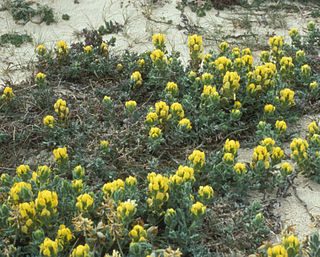
Castilleja mollis is a species of Indian paintbrush known by the common name softleaf Indian paintbrush. It is endemic to the Channel Islands of California, where it is currently known only from Santa Rosa Island. An occurrence was once noted on San Miguel Island, but the plant has not been found there since 1938. Its habitat is the coastal sage scrub around the windy sand dunes and bluffs.

Dudleya verityi is a rare species of succulent plant known by the common name Verity's liveforever. It is endemic to Ventura County, California, where it is known from only three occurrences in the vicinity of Conejo Mountain between Camarillo and Thousand Oaks. It probably occurs in a few additional locations nearby which have not yet been officially vouchered.
Hordeum intercedens is an diploid, annual species of wild barley known by the common names bobtail barley and vernal barley. It is native to southern California and northern Baja California, where it is an increasingly rare member of the flora in saline and alkaline soils near seasonal waterflows and vernal pool habitats. Today most occurrences are located on the Channel Islands of California; many of the occurrences known from the mainland have been extirpated in the process of land development. This is an annual grass growing erect to bent in small tufts with stems up to 40 centimeters long. The inflorescence is a green spike up to 6.5 centimeters long made up of awned spikelets between 1 and 2 centimeters long.

Orcuttia is a genus of grass in the family Poaceae. Plants grow up to 20 cm (8 in) tall, usually with many stems emerging from the base of the plant, and forming a tuft. The spikelets are several-flowered, with reduced upper florets. The lemma tips have between two and five teeth.

Oenothera californica, known by the common name California evening primrose, is a species of flowering plant in the evening primrose family.
Orcuttia inaequalis is a rare species of grass known by the common name San Joaquin Valley Orcutt grass.
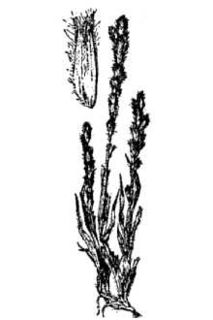
Orcuttia pilosa is a rare species of grass known by the common name hairy Orcutt grass.
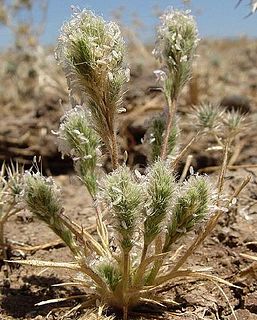
Orcuttia viscida is a rare species of grass known by the common name Sacramento Orcutt grass.
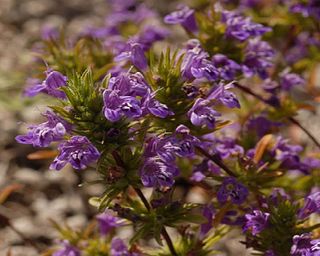
Pogogyne nudiuscula is a rare species of flowering plant in the mint family known by the common name Otay mesa mint. It is native to southern San Diego County, California, where it is known only from Otay Mesa near the border with Baja California. It was identified on land south of the Mexican border, but these occurrences have probably been extirpated. It is now known from seven vernal pool complexes just north of the border, and it is a federally listed endangered species of the United States.
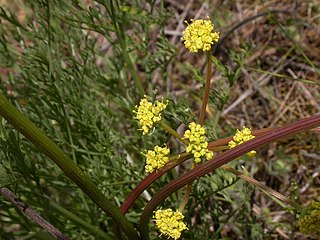
Lomatium cookii is a rare species of flowering plant in the carrot family known by the common names Cook's lomatium and agate desertparsley. It is endemic to Oregon in the United States, where it grows in only two valleys. It is a federally listed endangered species.

Thlaspi californicum is a rare species of flowering plant in the family Brassicaceae known by the common name Kneeland Prairie penny-cress. It is endemic to California, where it is known from only one stretch of grassland in Humboldt County. It is threatened by development. It is a federally listed endangered species of the United States.















